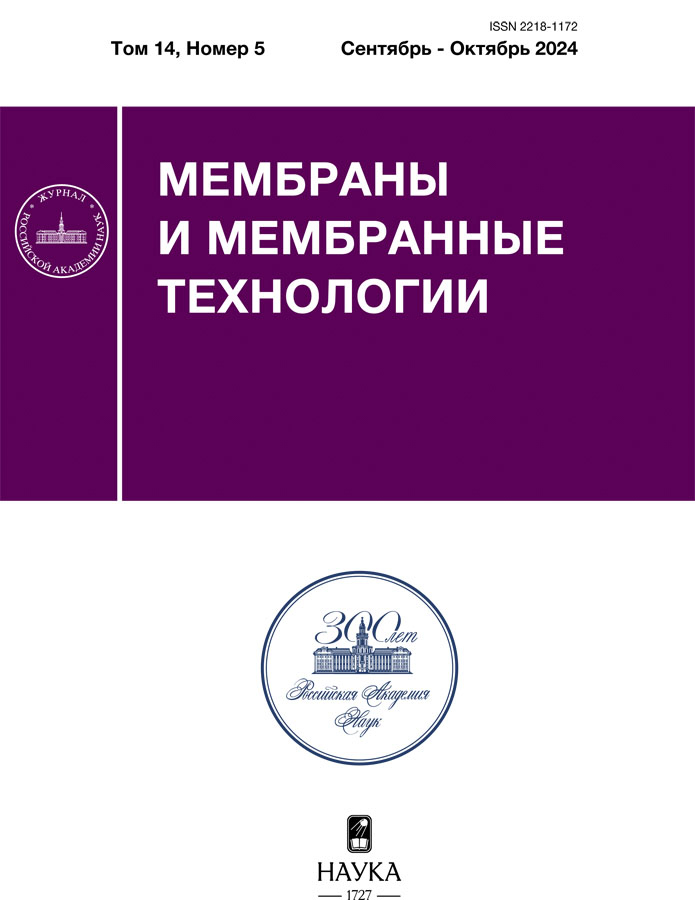Selective Permeability of a Homogeneous Bilayer Membrane MF-4SK with a Selective Layer of Cationic Polyelectrolyte in a Mixed Solution of Calcium Chloride and Sodium Chloride
- 作者: Achoh A.R.1, Bondarev D.A.1, Melnikov S.S.1, Zabolotsky V.I.1
-
隶属关系:
- Kuban State University
- 期: 卷 14, 编号 5 (2024)
- 页面: 358-367
- 栏目: Articles
- URL: https://ruspoj.com/2218-1172/article/view/677867
- DOI: https://doi.org/10.31857/S2218117224050026
- EDN: https://elibrary.ru/MYRLKI
- ID: 677867
如何引用文章
详细
New homogeneous bilayer membranes with a thin anion-exchange layer based on copolymer of N,N-diallyl-N,N-dimethylammonium chloride (DADMAC) and ethyl methacrylate (EMA) on the surface of sulfated polytetrafluoroethylene membrane-substrate have been developed. The general and partial current–voltage characteristics, external and intra-diffusion limiting currents were theoretically and experimentally investigated. The parameters of specific conductivity, sorption and diffusion permeability of individual membrane layers, as well as effective transfer numbers and specific selectivity of bilayer homogeneous membranes in mixed solutions of calcium chloride and sodium chloride have been determined.
It was found that depositing a thin anion-exchange layer of DADMAC and EMA on the homogeneous membrane can increase the selectivity of the membrane to single-charged cations. The specific selectivity of bilayer membrane MK-2 to sodium cations increases by more than 6 times (from 0.77 to 4.78) relative to the original homogeneous membrane-substrate MF-4SC.
Verification of the obtained experimental data in the framework of a four-layer mathematical model with quasi-equilibrium boundary conditions for the system diffusion layer (I)/modifying layer (II)/membrane-substrate (III)/diffusion layer (IV) in ternary solutions of NaCl+CaCl2 has been carried out.
全文:
作者简介
A. Achoh
Kuban State University
编辑信件的主要联系方式.
Email: achoh-aslan@mail.ru
俄罗斯联邦, Krasnodar, 149, Stavropolskaya St., 350040
D. Bondarev
Kuban State University
Email: achoh-aslan@mail.ru
俄罗斯联邦, Krasnodar, 149, Stavropolskaya St., 350040
S. Melnikov
Kuban State University
Email: achoh-aslan@mail.ru
俄罗斯联邦, Krasnodar, 149, Stavropolskaya St., 350040
V. Zabolotsky
Kuban State University
Email: achoh-aslan@mail.ru
俄罗斯联邦, Krasnodar, 149, Stavropolskaya St., 350040
参考
- Güler E., van Baak W., Saakes M., Nijmeijer K. // J. Membrane Science. 2014. V. 455. P. 254–270.
- Апель П.Ю., Бобрешова О.В., Волков А.В., и др. // Мембраны и мембранные технологии. 2019. Т. 9. С. 59–80.
- Grimm J., Bessarabov D., Sanderson R. // Desalination. 1998. V. 115. P. 285–294.
- Xu T. W., Huang C. H. // AIChE J. 2008. V. 54. P. 3147–3159.
- Tang W., He D., Zhang C., Kovalsky P., Waite T.D. //Water Res. 2017. V. 120. P. 229–237.
- Li X.F.,. Zhang H.M, Mai Z.S. et al. // Energy Environ. Sci. 2011. V. 4. P. 1147–1160.
- Qian Y., Huang L., Pan Y., et al. // Sep. Purif. Technol. 2018. V. 192. P. 78–87.
- Qiu Y., Park K. // Adv. Drug Delivery Rev. 2012. V. 64. P. 49–60.
- Титова Т.С., Юрова П.А., Кулешова В.А. // Мембраны и мембранные технологии. 2021. Т. 11. C. 460–468.
- Ter Veen W.R., Koene L. // Metal Finishing. 2003. V. 101. P. 17–27
- Zhou Y., Yan H., Wang X., et al. // J. Membrane Science. 2016. V. 520. P. 345–353.
- Nir O., Sengpiel R.G., Wessling M. // Chem. Eng. J. 2018. V. 346. P. 640–648.
- Boucher M., Turcotte N., Guillemette V., et al. // Hydrometallurg. 1997. V. 45. P. 137–160.
- Díaz Nieto C., Palacios N., Verbeeck K., et al. // Water Research. 2019. V. 154 P. 117–124.
- Lacour S., Deluchat V., Bollinger J.C., Serpaud B. // Talanta. 1998. V. 46. P. 999–1009.
- Горобченко А.Д., Гиль В.В., Никоненко В.В., Шарафан М.В. // Мембраны и мембранные технологии. 2022. Т. 12. С. 480–490.
- Sata T. // Royal Society of chemistry. 2007. V. 15. P. 68.
- Zabolotskii V., Sheldeshov N., Melnikov S. // J. Appl. Electrochem. 2013. V. 43. P. 1117–1129.
- Sata T. // J. Membrane Science. 1994. V. 93. P. 117–135.
- Abdu S., Wessling M. // ACS Applied Materials and Interfaces. 2014. V. 3. P. 1843–1854.
- Wang W., Liu R., Tan M., et al. // J. Membrane Science. 2019. V. 582. P. 236–245.
- Shkirskaya S., Kolechko M., Kononenko N. // Curr. Appl. Phys. 2015. V. 15. P. 1587–1592.
- Sata T., Izuo R. // J. Membrane Science. 1989. V. 45. P. 209–224.
- Golubenko D.V., Karavanova Yu.A., Melnikov S.S., et al. // J. Membrane Science. 2018. V. 563. P. 777–784.
- Bondarev D., Melnikov S., Zabolotsky V. // J. Membrane Science. 2023. V. 675. P. 121510.
- Nafion(tm) membranes and dispersions, URL: https://www.chemours.com/Nafion/en_US/index.html
- Заболоцкий В.И., Шельдешов Н.В., Шарафан М.В. // Электродимия. 2006. Т. 42. С. 1494.
- Заболоцкий В. И., Гнусин Н. П., Шеретова Г. М. // Журн. физ. химии. 1985. Т. 59. С. 2467–2471.
- Berezina N.P., Kononenko N.A., Dyomina O.A., Gnusin N.P. // Colloid Inter-face Sci. 2008. V. 139. P. 3.
- Ачох, А.Р., Заболоцкий В.И., Лебедев К.А., Шарафан М.В., Ярославцев А.Б. // Мембраны и мембранные технологии. 2021. Т. 11. С. 58–78.
- Demina O.A., Shkirskaya S.A., Kononenko N.A., Nazyrova E.V. // Russ. J. Electrochem. 2016. V. 52. P. 291.
- Nightingale E.R. // J. Phys. Chem. 1959. V. 109. № 43. P. 1381.
- Afanas’ev V.N., Tyunina E.Yu. // Russian Journal of General Chemistry. 2004. № 5. V. 74. P. 673.
- Zavitsas A.A. // J. Phys. Chem. 2005. V. 109. № 43. P. 20636.
- Sarapulova V.V., Titorova V.D., Nikonenko V.V., Pismenskaya N.D. // Membranes and Membrane Technologies. 2019. V. 1. P. 168–182.
- Gorobchenko A., Mareev S., Vikonenko V. // Int. J. Mol. Sci. 2022, 23(9), 4711; https://doi.org/10.3390/ijms23094711
补充文件

















